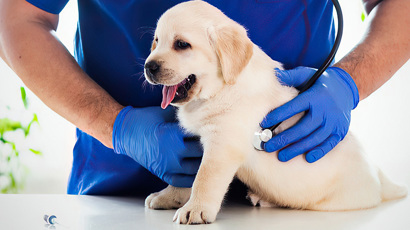Bee and Wasp Stings on Dogs: What to Look Out For

Insect stings from bees and wasps are quite common in dogs because they spend so much time outdoors, especially in the warmer months. Running and playing on grass and in bushes can put dogs at increased risk of an insect sting. Dogs are also curious creatures and this curiosity often leads to a sting from a bee or wasp on the face, muzzle area or inside the mouth.
When a bee stings a dog, the stinger comes away from the bee and lodges in the skin, killing the bee in the process, meaning they can only sting once.
Wasps, on the other hand, can sting multiple times if aggravated. These stings release venom which causes pain, mild swelling and discomfort.
In some cases, dogs may have an allergic reaction to a bee or wasp sting.
How to tell if a dog was stung by a bee or wasp
Bee stings are usually easy to identify if the venomous barbed sack is still lodged in your dog’s skin. If so, remove it by gently scraping it away trying to avoid damaging the sack in the process as this will release more venom.
Wasp stings are potentially more dangerous because they can sting numerous times.
A wasp sting on a dog will cause redness and swelling at the site of the sting(s).
Your dog may show signs including restlessness, whining, licking the affected area, pawing at their face or raising their paw if these are the affected areas. Often, a mild sting will cause temporary pain and discomfort which should subside after a short time.
Signs of allergic reaction to bee stings in dogs
Unfortunately, some dogs have allergic reactions to insect bites. Common signs that your dog has had an allergic reaction include:
- Severe swelling at the site of the sting
- Weakness
- Collapse
- Breathing difficulties
- Swelling resembling hives on the body.
Bee and wasp sting remedy for dogs: when to go to the vet
You can try treating the bee or wasp sting by applying an ice pack wrapped in a tea towel to the sting site to reduce the swelling, much as you would with a human bee sting. Give your pet fresh water to drink and try to keep them from scratching the sting as this may lead to infection.
IMPORTANT: If you suspect your dog has had an allergic reaction or they’ve had a bee or wasp sting inside or near their mouth, get them to a vet immediately.
Bee and wasp stings inside or near the airway can be life threatening because they cause swelling that reduces or prevents breathing.
If you have any concerns about your dog following a bee or wasp sting it’s best to seek veterinary treatment.
It’s also important to avoid encouraging your dog to chase or catch insects including flies. Although flies are harmless, if you reward your dog for catching and eating them, they may think bees and wasps are fair game!



